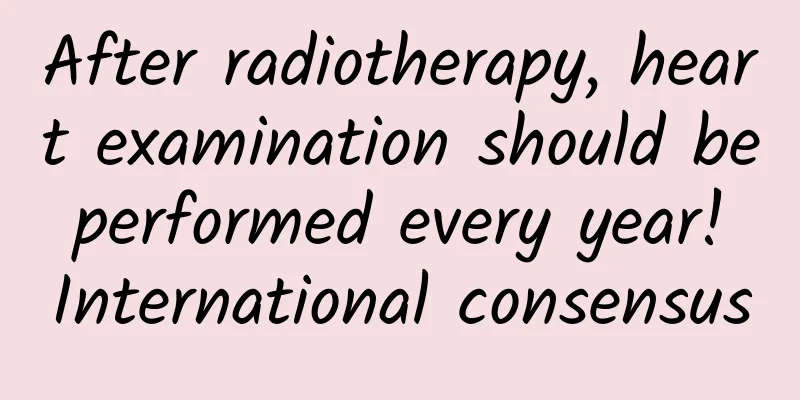After radiotherapy, heart examination should be performed every year! International consensus

|
Nowadays, due to the significant progress in cancer detection and treatment, more and more cancer patients are able to survive for a long time. However, among cancer survivors, the leading cause of death is no longer cancer, but has been replaced by cardiovascular disease. Data show that the risk of fatal heart disease in cancer patients is twice that of the general population. Therefore, cardio-oncology has received increasing attention in recent years. Radiotherapy is the cornerstone of cancer treatment, and more than 50% of cancer patients receive radiotherapy. Radiotherapy can have short-term and long-term adverse effects on blood vessels and the heart, such as causing atherosclerosis and dysfunction of heart valves, myocardium, and pericardium. Recently, the International Cardio-Oncology Society (ICOS) released the first multidisciplinary expert consensus on the cardiovascular manifestations of radiotherapy. The consensus emphasizes that contemporary radiotherapy techniques minimize radiation doses to healthy tissues, but there are cardiovascular risks at the radiotherapy site. Therefore, it is recommended to reduce radiation exposure to the cardiovascular system as much as possible without affecting cancer treatment. The consensus recommends that at baseline and every year thereafter, all patients receiving radiotherapy should undergo a comprehensive cardiovascular history inquiry and physical examination, evaluate cardiovascular risk factors such as hypertension and diabetes, assess whether there is atherosclerotic calcification based on CT examination results, and actively treat concomitant cardiovascular disease and its risk factors. The consensus points out that coronary artery calcium score is an important indicator for assessing cardiovascular risk. CT examinations are routinely performed during cancer screening or staging and when planning radiotherapy, which provides an opportunity to screen asymptomatic atherosclerosis and guide the implementation of preventive measures. This consensus provides guidelines for short-term and long-term cardiovascular disease screening for patients undergoing different radiotherapy sites (head and neck, chest, abdomen, and pelvis). Radiation therapy to the head and neck For patients who have received head and neck radiotherapy, it is recommended that auscultation be performed for the presence of a carotid bruit during regular physical examinations. In addition, these patients should undergo carotid ultrasound to screen for asymptomatic atherosclerotic plaques. Patients at higher risk (based on radiation dose and cardiovascular risk assessment) should have an initial evaluation 1 year after radiation therapy and follow-up evaluations every 3 to 5 years thereafter to help guide the implementation of preventive therapy. Patients after head and neck RT should also be screened for symptoms and signs of autonomic dysfunction, including vital signs during changes in body position. Chest radiation therapy For patients with cardiovascular risk factors undergoing mediastinal RT, a baseline electrocardiogram and complete transthoracic echocardiogram are useful. For patients who have previously received thoracic radiotherapy, CT scan results are reviewed to assess for coronary or aortic calcification to guide treatment of asymptomatic atherosclerosis. It is worth noting that the absence of coronary artery calcification shown by CT, especially non-gated CT, cannot completely rule out coronary artery disease. For patients who have undergone chest radiotherapy and have no history of atherosclerosis or cardiovascular assessment, further examination of coronary calcium score, coronary CT angiography or functional stress test is recommended during follow-up. Screening is recommended every 5 years based on the patient's overall cardiovascular risk. For patients at increased risk of cardiomyopathy after thoracic radiotherapy, transthoracic echocardiography or cardiac magnetic resonance imaging is recommended after completion of anticancer treatment. The timing of the first electrocardiogram after chest radiotherapy can be determined based on the patient's individual risk. For high-risk patients, it is recommended to perform the first electrocardiogram 6 to 12 months after radiotherapy. For all patients whose hearts were exposed to radiation during radiotherapy, an electrocardiogram is recommended within 5 years after radiotherapy. In addition, echocardiography and NT-proBNP measurement every 5 years are useful. For all patients whose hearts were exposed to radiation during radiotherapy, echocardiography is recommended 5 years after radiotherapy to evaluate for pericardial disease and subclinical valvular heart disease, and every 5 years thereafter. For patients whose radiotherapy field includes the subclavian artery, annual blood pressure checks in both arms are recommended to screen for subclavian artery stenosis. For patients whose radiation therapy field includes the subclavian artery and (or left internal mammary artery), such as those undergoing coronary bypass surgery, preoperative CT angiography or similar examination is recommended. Radiation therapy to the abdomen and pelvis For patients who have received abdominal or pelvic radiation therapy, screening for claudication, assessment of dorsalis pedis pulses, and auscultation for aortic or renal artery bruits are recommended. Evaluation for radiation nephropathy and/or renal artery stenosis is useful in patients who have received abdominal or pelvic radiation therapy and have worsening renal function and/or systemic hypertension. Prevention of cardiovascular disease after radiotherapy Regular screening and active treatment of cardiovascular risk factors and cardiovascular disease are recommended for all patients after radiotherapy. Screening intervals should be based on the patient's risk. At least annual screening is useful. Patients who have had thoracic radiation therapy should carefully weigh the advantages and disadvantages of surgery and interventional treatment for valvular heart disease or coronary artery disease because of the increased surgical risks. Interventional treatment is usually more advantageous, especially in patients with high mediastinal radiation doses or those who have had cardiac surgery. For patients who have undergone chest radiotherapy and have diastolic heart failure, restrictive cardiomyopathy or restrictive pericarditis should be considered. For patients who have undergone chest radiation therapy and are diagnosed with restrictive pericarditis but do not respond to initial medical therapy, pericardiectomy may be considered. Surgical risk is high, but timely surgery before disease progression can improve the condition. Source: China Circulation Magazine |
<<: Bizarre: A review of the top 10 retractions in the life sciences in 2021
Recommend
83.4 meters, the life-size photo of "China's tallest tree" released! How was it measured?
On October 9, the Chinese Giant Tree Expedition T...
APP promotion: How to operate an APP without financial support?
Because we mainly talk about how to operate and p...
The romantic rise and fall of WeChat public accounts
[[247951]] Prequel On July 21, 2012, Beijing, whi...
18 lessons on "Making Money by Selling Goods Online" to teach you how to write hot-selling and profitable copywriting
18 Lesson Outline of "Making Money by Sellin...
PC Taobao single product analyzer is a must-have for merchants_non-toxic software
Those who understand this tool will naturally und...
Distribution mini program mall, how long does it take to produce a distribution mini program?
As of now, the number of mini programs has reache...
From IP to CP: New Brand Operation Methodology
With the rise of Taobao platforms, a large number...
Why did the 3-meter-tall distant relatives of humans become extinct? New research finds that it was because of "poor diet"
A paleontologist once said that finding secrets i...
Craving some nuts in the morning? Don’t eat stale nuts!
Nuts have always been the first choice of snacks ...
Which fruits and vegetables have been sent to space? Tips on choosing fruits and vegetables sent to space
On June 5, the Long March 2F Yao-14 carrier rocke...
Did people in the Song Dynasty love to admire plant "fossils"? Tree-shaped stone: I am a "fake"!
"There is a stone screen in Shu, with small ...
Under what circumstances will the Douyin store deposit be deducted? Why was the Douyin store deposit deducted?
Since the establishment of Douyin store groups, m...
Weekly Science | Answers to common questions from parents about children's vision protection
Myopia prevention and control Recently, we have s...
iOS15 is coming with new features that are both surprising and worrying. Are you looking forward to it?
In the past few days, Apple officially announced ...
13 case studies teach you 3 tricks to achieve 0-budget planning of a million-PV event
In a startup company, both personnel and support ...





![Fengyun Media Douyin live streaming practical course: 3 days to blow up the live broadcast room and 7 days of stable natural flow gameplay [Video course]](/upload/images/67cc2dee27078.webp)



